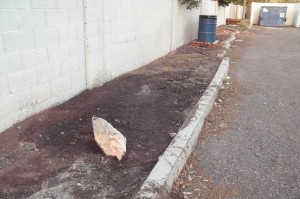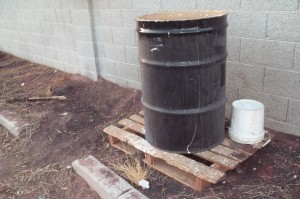In the January 13, 2015 Federal Register the USEPA announced its Final Rule for the Definition of Solid Waste (2015 DSW) which revised – and is supposed to correct deficiencies in – the 2008 Definition of Solid Waste Final Rule (2008 DSW). Though announced, the 2015 DSW does not become effective until July 13, 2015 and then only at the Federal level and in states without an authorized hazardous waste program.
A full summary of the 2015 DSW can be found at the USEPA Website for its DSW Rulemakings. The purpose of this article is to explain one small – but important – part of the 2015 DSW: The codified definition of “contained”.
The 2008 DSW lacked a codified definition of “contained”. Instead, in the preamble to the Final Rule at 73 FR 64681 USEPA noted that, “Generally, such material is ‘contained’ if it is placed in a unit that controls the movement of the hazardous secondary material out of the unit and into the environment.” It was felt that this lack of a codified definition of “contained” could result in mismanagement of hazardous secondary materials during storage and contribute to contamination of the environment.
The 2015 DSW takes away any ambiguity by including a codified definition of “contained” at 40 CFR 260.10 Definitions and will read as follows:
Contained means held in a unit
(including a land-based unit as defined
in this subpart) that meets the following
criteria:
(1) The unit is in good condition, with
no leaks or other continuing or
intermittent unpermitted releases of the
hazardous secondary materials to the
environment, and is designed, as
appropriate for the hazardous secondary
materials, to prevent releases of
hazardous secondary materials to the
environment. Unpermitted releases are
releases that are not covered by a permit
(such as a permit to discharge to water
or air) and may include, but are not
limited to, releases through surface
transport by precipitation runoff,
releases to soil and groundwater, windblown
dust, fugitive air emissions, and
catastrophic unit failures;
(2) The unit is properly labeled or
otherwise has a system (such as a log)
to immediately identify the hazardous
secondary materials in the unit; and
(3) The unit holds hazardous
secondary materials that are compatible
with other hazardous secondary
materials placed in the unit and is
compatible with the materials used to
construct the unit and addresses any
potential risks of fires or explosions.
(4) Hazardous secondary materials in
units that meet the applicable
requirements of 40 CFR parts 264 or 265
are presumptively contained.

Key points of this new definition include:
- Hazardous secondary material must be held in a unit.
- “Land-based unit as defined in this subpart” will include a pile.
- Unit must be in good condition with no leaks or unpermitted release of the hazardous secondary material to the environment. And, is designed to prevent such releases.
- Unit is properly labeled or has a system (such as a log) to immediately identify the hazardous secondary material in the unit.
- Unit is compatible with the hazardous secondary material.
- Unit design addresses any potential risk of fires or explosions.
Question: What is meant by “unit” in the new definition of “contained”?
Answer:
Unfortunately, “unit” is not defined specifically at §260.10 though its use there reveals the USEPA’s intent for this term. A “unit” as used by USEPA regulation refers to an article, device, structure, container, or some other distinct area where regulated materials are managed. Use of the word “unit” in USEPA regulations includes, but is in no way limited to, the following:
- Wastewater treatment unit
- Hazardous waste management unit
- Replacement unit
- Elementary neutralization unit
Taken together, the new definition of “contained” and the lack of a definition for “unit” provides flexibility in how compliance with this requirement is attained. This is a performance standard, meaning that compliance is determined more by the desired result, i.e. the hazardous secondary material remains within the “unit” and does not pollute the environment by its lack of containment, and less by any specified technical requirements, i.e. “hazardous secondary material must be contained in a tank or container…” For example, a “unit” for scrap metal could be an uncovered pile placed on the ground since it is unlikely to be carried off by wind or rain; conversely, a “unit” for spent solvent would likely be a closed tank or container due to its volatile nature and spill potential.

It is possible that a hazardous secondary material can be in compliance even though it does not strictly adhere to the new definition of “contained”. In this case, the hazardous secondary material may be held in a unit that complies with the requirements of 40 CFR 264/265, Subpart J (for hazardous waste in tanks) or 40 CFR 264/265, Subpart I (for hazardous waste in containers), in which case it is presumed to meet the requirements of the new “contained” definition.
Like this article? Subscribe to my Monthly Newsletter No marketing emails! |
Once included in 40 CFR 260.10 – Definitions, the new “contained” definition could be referred to and used as a standard by other regulations. However, as of July 13, 2015 it is only a factor for those seeking compliance with the two conditional exclusions from the definition of solid waste that were themselves further revised by the 2015 DSW and the new legitimacy criteria provision at §260.43. The revised regulations that will refer to the new “contained” definition are:
- Generator-Controlled Exclusion at 40 CFR 261.4(a)(23).
- Verified Recycler Exclusion (replacing the Transfer-Based Exclusion) at 40 CFR 261.4(a)(24).
- The Legitimacy Provision at 40 CFR 260.43.
It is interesting to note that the new Verified Recycler Exclusion at 40 CFR 261.4(a)(24) – the same as the old Transfer-Based Exclusion – requires an intermediate facility or reclaimer of the hazardous secondary material to manage it in a specific manner:
(D) The reclaimer and intermediate
facility must manage the hazardous
secondary material in a manner that is
at least as protective as that employed
for analogous raw material and must be
contained.
The use of the word “contained” here does not refer to the new definition of “contained” to be included at 40 CFR 260.10, so the reclaimer or intermediate facility does not yet have a codified definition of “contained” to refer to.
Daniels Training Services 815.821.1550 |
The 2015 DSW has far-reaching implications for all hazardous waste generators. Contact me to discuss what you need to do to ensure compliance.
